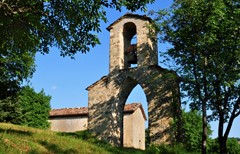Municipality of Montese.
Montese, the fortress and the domination of the Montecuccoli family over the centuries
Continuing our exploration of the central Frignano region on the trail of the Montecuccoli family, once again we delve into the history of the Municipality of Montese, a village of medieval origin nestling amongst the woods and valleys of the Apennines of Modena, to the east, between the Reno and Panaro rivers.
The Montecuccoli of Montese branch of the family, originated by Count Bersanino, on the death of his father Cesare in 1506, is one of the most abounding in illustrious personalities, who also happened to be contemporaries of Raimondo Montecuccoli and had dealings with him.
When young Raimondo emigrated to Austria to enrol in the Imperial army, Ernesto and Girolamo had already been accomplished generals of it for some time. Indeed, Raimondo began his career under the orders of Ernesto, even though the latter would soon die in a fateful battle during the Thirty Years’ War. It was Ernesto’s German army that fought in Italy in the Monferrato war mentioned by Manzoni in his novel “The Betrothed”. Some years later Girolamo too died and Raimondo fell heir to his rich patrimony which proved fundamental for his career as commandant. Also the Castle of Hohenegg in Austria had belonged to Girolamo, which Raimondo chose as his favourite residence and where he retired often to recover from the fatigues of war and diplomacy, and dedicate himself to his beloved studies.
The territory of Montese was part of the vast fiefdom granted to the Montecuccoli by Emperor Otto IV in 1212 and for the most part remained in their hands until the late 1600s. Due to the great poverty of these lands and also a certain lack of administrative ability, the last feudatory, Ferrante Montecuccoli, relinquished the Montese fiefdom in 1697, while retaining Ranocchio, what is now San Giacomo Maggiore, and San Martino.
The fortress, where earlier structures are no longer visible, dates back to the end of the 14th century; however its current appearance is the result of recent restoration and rebuilding after centuries of devastation, above all during the Second World War. The typology appears the same as the small fortresses built by the Montecuccoli at Renno di Sopra, Montecenere and Semese, consisting of a set of buildings enclosed within several circles of walls and including a feudal palace, a tall tower and two courtyards containing an underground cistern to collect water.
The choice of materials used is interesting; for the most part stone and tuff from a local quarry, used to build the portals. Nowadays the palace is home to a history museum dedicated to the Second World War and, in particular, to the Brazilian contingent who liberated Montese in 1945.
As in many other places, also the artistic heritage of the Montese area is thanks to the munificence of the Montecuccoli, who endowed the churches with precious treasures, paintings and furnishings. At San Giacomo Maggiore Count Orazio had the belltower built in 1617 and donated to the church a painted panel which portrays him in the act of prayer. In the church, decorated with some family coats of arms, is a magnificent large tombstone of Count Francesco from 1588: it is richly ornamented, and surmounted by the family crest and an inscription that recalls the construction of the tomb, which the count had ordered that year for himself and his heirs.
Just past San Giacomo, ascending towards the town, we come across the hamlet of San Martino, where two large gravestones in the church commemorate Ercole Montecuccoli, who died in 1619, and the school he founded through his last will and testament. The school continued its activities through thick and thin until the late 1800s, when the economic ruin of the Montecuccoli family cut off its supply of funds.
Not far from Montese are Monteforte and Riva. Substantial traces remain of the castle built to guard the border with Bologna at Monteforte whose most celebrated feudatory was Lancellotto Montecuccoli, ally of Obizzo da Montegarullo in the early 1400s against the Este family. In particular it contains a splendid fresco cycle dating back to around 1450. Instead there are frescoes from around 1430 at Riva, a fortified village largely destroyed following the spates of violence that constantly ravaged the Frignano region during the first half of the 1500s. Indeed it was in this period, while the papal armies were occupying Modena, that, profiting from the occasion, and in contempt of Bersanino Montecuccoli, these places became self-governing for several years, until they eventually returned to being ruled by their former feudatories.
